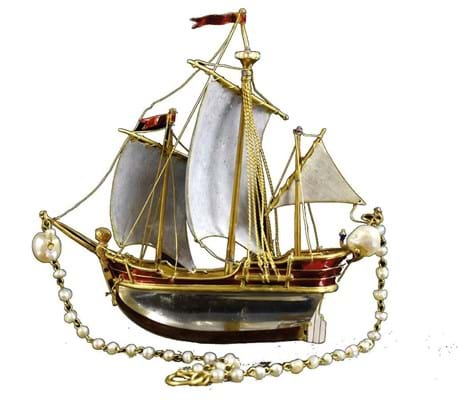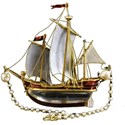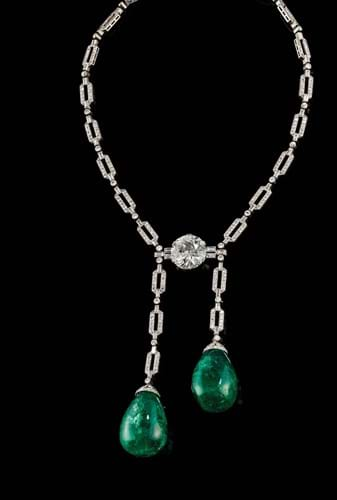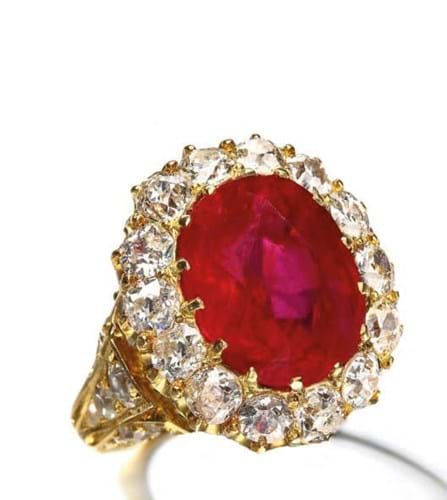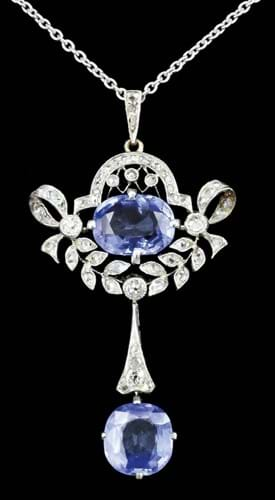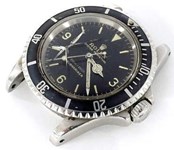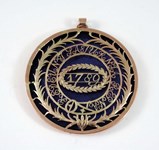On July 19, 1909, Hubert Latham (1883-1912) took off from Cap Blanc-Nez, several miles west of Calais, in his Antoinette IV monoplane, hoping to be the first man to cross the English Channel.
He managed just eight of the 20-something miles before an engine failure forced the first-ever landing of an aircraft on the sea. The fuselage remained afloat, so Latham lit a cigarette and awaited rescue by a nearby French destroyer.
Six days later, Louis Blériot took advantage of a break in the weather to make the same journey in his Type XI monoplane to claim a £1000 prize and his name in the history books.
An 18ct gold and white metal brooch depicting the Antoinette IV or VII monoplane formed part of a strong selection of period jewellery offered by Bamfords in Derby on September 28. Estimated at £100-150, it made £2100.
Also on the transport theme was an unusual pendant worked as a three-masted ship with a rock crystal hull, enamelled sails and pennants and a pearl set chain.
It too improved markedly on estimate, selling at £3800. However, the surprise result was the performance of a gold and silver-coloured metal damascene cross link guard chain. Composed of 72 individually decorated cross sections with ring link connectors and a spring loop clasp, it had shades of the historicism practised by Robert Phillips and other Victorian revivalists. The winning bid, against a token £100-200 estimate, was £5800.
Metal detector discovery
An Anglo-Saxon gilt metal and enamel brooch, dug up by a metal detector in Surrey, sold for £6800 (estimate £3000-5000) at Duke’s in Dorchester on October 12.
Dating from the 9th-11th centuries, its salient feature is a portrait head recalling the haunting cloisonné enamel face (thought to represent the sense of sight) that centres what is perhaps the best known example of Anglo-Saxon goldsmithing, the Alfred Jewel in the Ashmolean.
Duke’s 4cm brooch, enamelled in four colours, was almost complete, missing two of the four enamel pellets to the border.
Sold at £6400 (estimate £2000-4000) was another metal detecting find, a medieval (probably 15th century) ring decorated with a garnet and engraved leaves on a hatched ground.
It was found in Rampisham, Dorset in November 2014 with another gold ring – worked with a band of four decorated annular brooch motifs and gothic letters – uncovered on the same spot. This glove ring was also offered in the sale but failed to find a buyer.
Art Deco house record
The Piguet saleroom in Geneva set a new house record for jewellery on September 29 when a spectacular Art Deco necklace set with emeralds sold at Sfr520,000 (£390,000), five times the estimate of Sfr80,000-120,000.
The set came for sale from the Lake Geneva home of France’s first female property developer, Molly de Balkany. The often lavish furniture and works of art from the estate were sold by the auctioneer in May.
The principal stones in the necklace are two untreated Columbian emerald drops (of 75 and 78ct) and an old-mine-cut diamond weighing around 14ct.
From the same collection was a Belle Epoque brooch double bow and ribbon by Cartier sold in its fitted case at a double-estimate SFr190,000 (£142,860).
Set with old-cut diamonds, the lower ribbon retains a drop emerald of approximately 23ct with the upper bow ribbons suspending drops to either side of 3.9 and 4ct. Again, the SSEF (Swiss Gemological Institute) report stated the stones were Columbian.
Holding its value
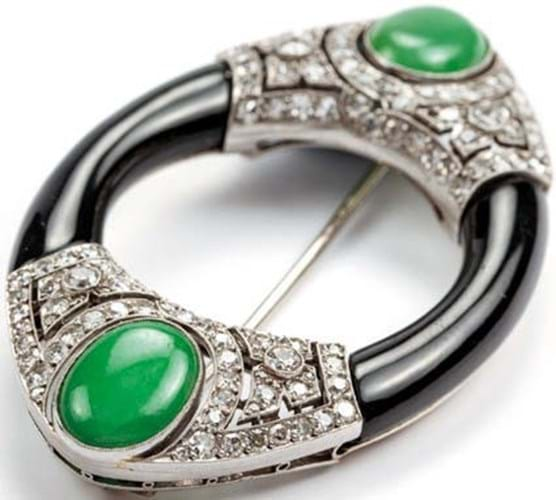
Deco jade, onyx and diamond brooch by Boucheron – £22,000 at Cheffins.
“Art Deco jewellery has held its value the best of all jewellery styles,” says Angela Marshall, jewellery specialist at Cheffins. This diamond, jade and black onyx brooch by Boucheron sold for £22,000 in Cambridge on October 18.
Designed as an open navette, the flower and foliate carved plaques are hand engraved with the characteristic Boucheron signature, and ‘Paris’ in the same script. The heritage department at Boucheron confirmed that the signature is correct and that the brooch dates from c.1925.
Top standards
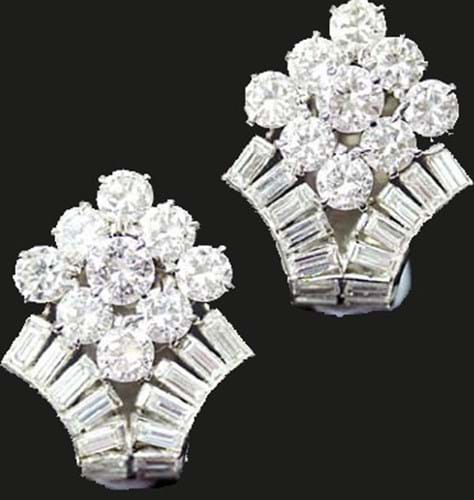
Cartier diamond and platinum ear clips – £27,000 at Batemans.
Jewellery by the top French ateliers provides the gold standard by which others are judged. A pair of Art Deco diamond and platinum ear clips c.1930 combining brilliant and baguette cut stones with a total value of around 3.2cts sold for a house record £27,000 (estimate £5000-8000) at Batemans in Stamford on October 7.
Both were signed Cartier London and were in the original gilt tooled red leather Cartier case. They came from the estate of Joseph B Hay, the son of Major General Arthur K Hay.
Phone frenzy
Another house record for jewellery was posted at Chiswick Auctions on September 12 when a large Burmese ruby sold for £120,000. A total of 14 phone lines provided the competition.
“The moment we saw the ring I knew that this was something of exceptional quality and importance,” said Sarah Duncan, head of jewellery at Chiswick Auctions.
The 6.51 untreated carat ruby was a gift to the vendor from a member of an Asian royal family.
Ruby Thursday
Quality coloured gemstones in period settings are highly sought-after in the current market. At the Lymington saleroom of George Kidner on October 12 a ruby five stone half hoop ring sold at £24,000. Again it was sold with a recent certificate identifying all five oval/cushion-shaped stones as Burmese with no signs of heat treatment.
In the same sale a typical Victorian diamond crescent brooch, comprising a row of old brilliant-cut stones including one of around 1.25 carats sold in a fitted case for £11,000.
Pendant impresses
Most wanted among the jewellery at The Canterbury Auction Galleries on October 3 was an Edwardian gold and silver-mounted sapphire and diamond pendant. The principal stones were an oval sapphire of 4.4ct, and a circular sapphire of 3.60ct with a GCS report confirming both to be of Ceylonese origin with no indication of heat treatment. It sold to a private buyer from London at £7000.
Family provenance
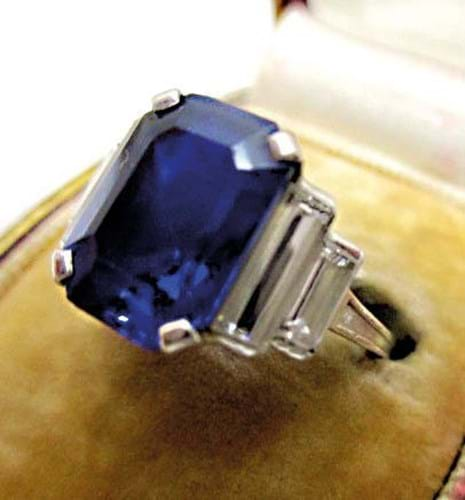
Deco Ceylonese sapphire ring – £27,000 at Bourne End Auction Rooms.
The inclusion of an Art Deco Ceylonese sapphire ring set with baguette cut diamonds brought Bourne End Auction Rooms’ quarterly Silver & Jewellery Auction to the attention of London jewellery dealers. The ring, with a central stone of around 4.75ct, came for sale from a local lady and had been in her family since the 1920s.
Ten phones were attracted by the estimate of £1200-1500, but the business end of the bidding came via a private buyer and a dealer in the room who was taking instructions via a phone. The latter eventually secured it for £27,000.



